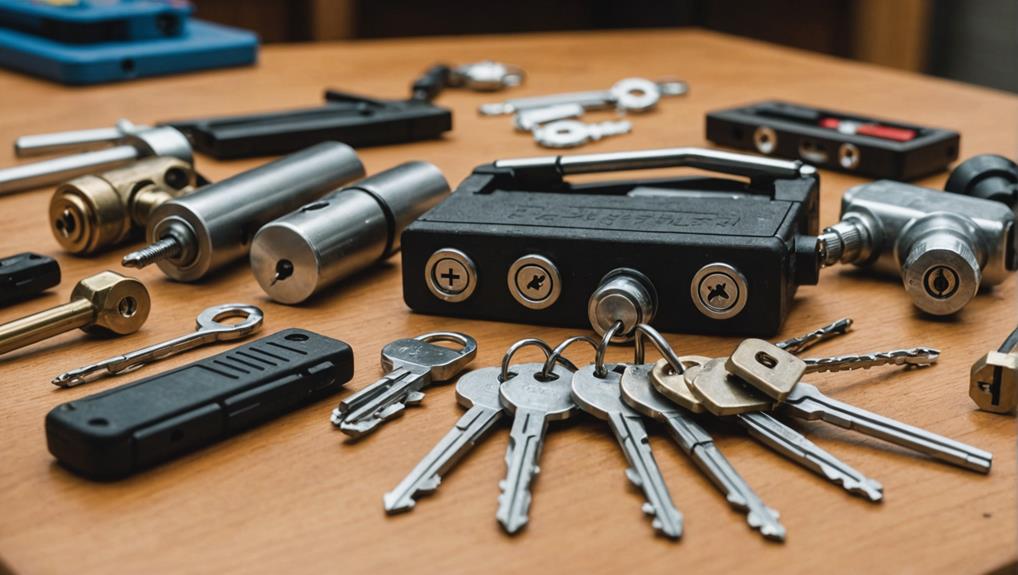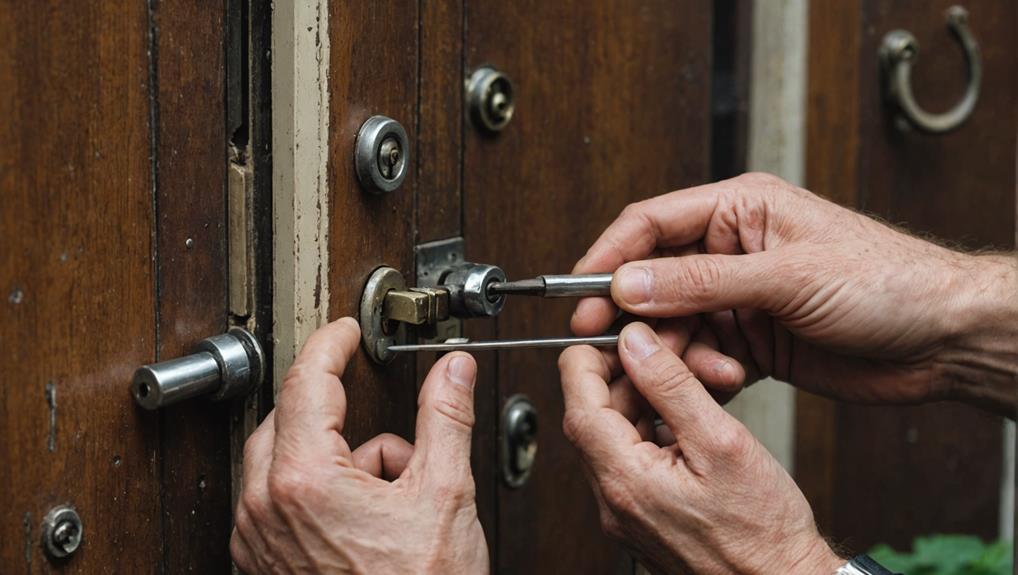Installing high-security locks yourself can enhance your home's protection while saving on professional costs. First, choose the right lock for your needs, like deadbolts or smart locks. Gather essential tools such as a screwdriver, drill, tape measure, and chisel. Remove the old lock by unscrewing and disassembling it carefully. Align and install the new lock, securing all components firmly. Finally, test the lock's operation by turning the key and ensuring smooth functioning. You're just a few steps away from mastering this vital security upgrade!
Key Takeaways
- Evaluate the level of security needed and choose a high-security lock with durable materials and a high ANSI rating.
- Gather necessary tools, including screwdrivers, power drill, measuring tape, pencil, chisel, and hammer.
- Remove the old lock by unscrewing and disassembling all components carefully to avoid damage.
- Follow the lock's template to mark drilling points, then secure the deadbolt and attach exterior and interior parts.
- Test the lock's functionality by turning the key multiple times and ensuring smooth extension and retraction of the deadbolt.
Choosing the Right Lock

When it comes to securing your home or business, choosing the right lock is essential. You want to guarantee the safety of those you care about and the integrity of your property.
Start by evaluating your specific needs. Are you looking to secure a high-traffic area, or do you need a lock for a seldom-used door? This will help you decide between different types of locks such as deadbolts, smart locks, or padlocks.
Consider the level of security you require. For high-security needs, deadbolts are often the best option. They provide robust protection against forced entry.
Smart locks offer convenience and advanced security features, like remote access and monitoring. If you're securing outdoor items or gates, padlocks might be the way to go.
Quality is key. Look for locks made from durable materials like hardened steel.
Check for certifications such as ANSI (American National Standards Institute) ratings, which can guide you in choosing the right lock. A higher ANSI rating indicates better security and durability.
Lock installation might seem intimidating, but with the right tools and guidance, it can be a straightforward process.
Gathering Necessary Tools

To install high-security locks efficiently, you'll need to gather the necessary tools first. As someone who enjoys helping others, you know the importance of being well-prepared. By having everything ready, you guarantee a smooth DIY lock installation process, saving time and reducing stress.
Understanding choosing the right locks for different entry points can also provide valuable insight during this process.
First, you'll need a Phillips head screwdriver and a flathead screwdriver. These are essential for removing screws from the old lock and securing the new one.
Next, grab a power drill and a set of drill bits. A power drill makes it easier to create or widen holes for the lock mechanism.
A tape measure is vital for confirming the new lock fits perfectly. Accuracy here can make all the difference.
Have a pencil handy for marking where you'll need to drill or make adjustments. Also, keep a chisel and hammer nearby. These tools help in shaping the door frame to accommodate the high-security lock's components.
Don't forget a level to guarantee your lock is aligned correctly. Misalignment can compromise the lock's effectiveness.
Removing the Old Lock

With your tools gathered, it's time to tackle the task of removing the old lock. This step is vital to guarantee the new high-security lock fits perfectly and functions smoothly.
Before you begin, make certain you have the necessary tools, such as a screwdriver and possibly a drill, to handle any stubborn screws.
Follow these steps to efficiently remove the old lock and prepare for the new one:
- Remove the Screws: Locate the screws on the interior side of the lock. Using a screwdriver, carefully unscrew and set them aside. This will allow you to detach the interior and exterior parts of the lock.
- Disassemble the Lock Mechanism: Once the screws are removed, gently pull apart the lock mechanism. Be mindful of any additional components, such as the latch or deadbolt, which may require a bit of maneuvering to remove.
- Extract the Latch: With the main parts of the lock disassembled, focus on removing the latch from the door edge. Use your screwdriver to unscrew it and carefully slide it out.
Installing the New Lock

Fitting a new high-security lock onto your door can greatly enhance your home's security. Start by gathering your tools: a screwdriver, drill, measuring tape, and the high-security lock kit.
While selecting your lock, consider some of the top high-security locks available on the market for peak protection.
First, align the new lock's template on the door, making certain it's level. Mark the points for drilling, then carefully drill the necessary holes.
Next, insert the new deadbolt into the hole. Make sure it fits snugly, then secure it with screws provided in the kit.
Now, place the exterior part of the lock on the door, aligning it with the deadbolt. Attach the interior part, confirming they connect properly. You'll want to double-check that the lock cylinder turns smoothly before tightening the screws.
Once the main lock is in place, install the strike plate on the door frame. This is essential for the lock's effectiveness.
Align it with the bolt, mark the screw locations, and drill pilot holes. Attach the strike plate with screws, making sure it's firmly in place.
Testing the Lock

Now that the lock is installed, it's vital to test it thoroughly to confirm it functions correctly. This step verifies that your step-by-step lock installation was successful and that the lock is ready to serve and protect those you care about.
It's also important to follow best practices for maintaining residential security systems to extend the lifespan of your lock.
Here's a simple process to follow:
- Check the Locking Mechanism: Insert the key and turn it to lock and release the door several times. Confirm there's no resistance, and the key turns smoothly without sticking. If you encounter any issues, recheck the alignment of the lock components.
- Test the Deadbolt: If your high-security lock includes a deadbolt, make sure it extends and retracts fully when you operate the thumb turn or key. The deadbolt should engage smoothly with the strike plate. If it doesn't, you may need to adjust the strike plate for better alignment.
- Examine the Door's Fit: Confirm the door closes securely with the lock engaged. The door should fit snugly into the frame without needing excessive force. This verifies that the lock will be effective in securing the door against forced entry.
Frequently Asked Questions
Can High-Security Locks Be Installed on All Types of Doors?
Yes, you can install high-security locks on almost any type of door.
Whether it's a wooden door, metal door, or even a glass door with a suitable frame, there's a high-security lock designed for it.
By upgrading your locks, you're providing peace of mind for those you care about.
Just make sure the door and frame are sturdy enough to support the new lock, ensuring everyone's safety and security.
How Often Should High-Security Locks Be Maintained?
You should maintain high-security locks at least once a year to guarantee they function properly and provide the best protection.
Regular maintenance involves lubricating the lock, checking for wear and tear, and confirming all components are secure.
By keeping your locks in top shape, you're not only preserving their longevity but also safeguarding the safety and security of those you serve.
Don't forget to schedule this essential task!
Are There Any Legal Restrictions on Installing High-Security Locks?
Yes, there can be legal restrictions on installing high-security locks, especially if you're a tenant.
Always check your lease agreement and consult with your landlord.
In some areas, local ordinances might require permits or adherence to specific building codes.
Remember, ensuring the security of others while following the law is essential.
Your effort to protect and serve those around you starts with understanding and respecting these regulations.
What Are the Common Mistakes to Avoid During Installation?
When you're installing high-security locks, don't rush the process. Measure accurately before drilling to avoid misalignment.
Make certain you're using the right tools for the job to prevent unnecessary damage. Double-check that the locks are compatible with your door type.
Don't forget to test the lock multiple times before finishing up. By paying attention to these details, you'll guarantee that your work provides secure and reliable protection for others.
How Can I Ensure the Lock's Longevity?
To guarantee your lock's longevity, regularly clean and lubricate it using a graphite-based product.
Avoid using oil-based lubricants as they attract dust and grime.
Check for any loose screws and tighten them periodically.
Make sure the door aligns correctly with the lock to prevent undue stress.
Conclusion
You've done it! By choosing the right lock, gathering the necessary tools, removing the old lock, and installing the new one, you've successfully upgraded your home's security. Remember to test the lock to verify everything works smoothly. With your new high-security lock in place, you can enjoy greater peace of mind knowing your home is better protected. Great job on taking this important step towards securing your home on your own!









